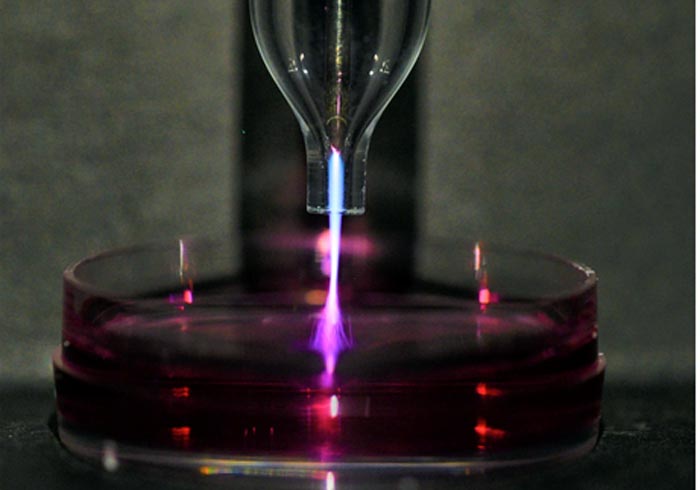Defining plasma dose for potential future cancer treatments

Plasma-activated medium for cancer treatment.
Credit: He Cheng, Jingyi Luo, Ke Song, Feng Zhao, Dawei Liu, Lanlan Nie, and Xinpei Lu
Equivalent total oxidation potential of a plasma-activated medium has implications for cancer treatments.
Chinese researchers may have found a new approach to treat cancer by using a plasma treatment to induce apoptosis, the death of cancer cells, without any obvious side effect to normal cells.
The catch is that while a plasma-activated medium (PAM) can be treated as a drug, there is always a dose-effect relationship. And within the plasma community, many researchers are defining the plasma dose as either the plasma treatment time or the power deposited to plasma per surface.
In Physics of Plasmas, from AIP Publishing, the scientists’ definition of a plasma dose, the equivalent total oxidation potential (ETOP), can be used for PAM to reveal the plasma dose-response relationship for different cell types. ETOP is based on the oxidation potential of reactive oxygen and nitrogen species.
Plasma treatment time and the power deposited to plasma per surface “are not the right choices to define the plasma dose,” said Xinpei Lu, from Huazhong University of Science and Technology. “The essential part of the plasma treatment is the reactive species delivered to PAM. The definition of the plasma dose we present is based on this reactive species concentration.”
The goal of plasma medicine is to exploit a differentiated interaction of specific plasma components with specific elements or functionalities of living cells to control and, ideally, normalize therapeutic effects. One critical constraint on the path from the laboratory bench to bedside is the dose-response relationships of plasma on biological objects.
“Therefore, the determination of plasma dose is of critical biological importance for plasma’s clinical application,” said Lu. “For future plasma therapies, such as cancer treatment, our results suggest ETOP may be a well-defined strategy to evaluate its effects, because it provides the basis for significant lethality differences between normal and cancer cells.”
A plasma dose should be representative of the plasma’s contribution to the biological effect. In clinical pharmacology, this dose is most commonly measured by compounds in medicine for therapeutic purposes.
Although a broad spectrum of biological effects of plasma has been found and most distinctive plasma agents have been detected, two questions remain. How are these elements integrated into the plasma dose? How can we study the plasma dose-effect relationship?
ETOP is a preliminary attempt to answer these questions. Although it was already validated by a previous study done by the same team of researchers, whether ETOP is applicable for PAM was unclear. They note the applicability of ETOP or PAM, as well as corresponding plasma dose-response relationships, should be further studied.
“To our surprise, through data analysis, a good fit between experimental data and ETOP was found,” said Lu. “This suggests ETOP as a plasma dose is also suitable for PAM. We also found ETOP can be used to maximize the lethality difference between normal/cancer cells. Further validation by the published literature again indicates ETOP may provide a well-defined strategy to evaluate the selectivity of PAM treatment on different cell types.”
The article “On the dose of plasma medicine: Plasma-activated medium (PAM) and its effect on cell viability” is authored by He Cheng, Jingyi Luo, Ke Song, Feng Zhao, Dawei Liu, Lanlan Nie, and Xinpei Lu. The article will appear in Physics of Plasmas on June 28, 2022 (DOI: 10.1063/5.0089357). After that date, it can be accessed at https://aip.scitation.org/doi/10.1063/5.0089357.
ABOUT THE JOURNAL
Physics of Plasmas is devoted to the publication of original experimental and theoretical research that significantly advances the field of plasma physics. The journal also features comprehensive reviews, advanced tutorials, and forward-looking perspectives. See https://aip.scitation.org/journal/php.
Journal: Physics of Plasmas
DOI: 10.1063/5.0089357
Article Title: On the dose of plasma medicine: Plasma-activated medium (PAM) and its effect on cell viability
Article Publication Date: 28-Jun-2022
Media Contact
Larry Frum
American Institute of Physics
media@aip.org
Office: 301-209-3090
All latest news from the category: Physics and Astronomy
This area deals with the fundamental laws and building blocks of nature and how they interact, the properties and the behavior of matter, and research into space and time and their structures.
innovations-report provides in-depth reports and articles on subjects such as astrophysics, laser technologies, nuclear, quantum, particle and solid-state physics, nanotechnologies, planetary research and findings (Mars, Venus) and developments related to the Hubble Telescope.
Newest articles

Innovative 3D printed scaffolds offer new hope for bone healing
Researchers at the Institute for Bioengineering of Catalonia have developed novel 3D printed PLA-CaP scaffolds that promote blood vessel formation, ensuring better healing and regeneration of bone tissue. Bone is…

The surprising role of gut infection in Alzheimer’s disease
ASU- and Banner Alzheimer’s Institute-led study implicates link between a common virus and the disease, which travels from the gut to the brain and may be a target for antiviral…

Molecular gardening: New enzymes discovered for protein modification pruning
How deubiquitinases USP53 and USP54 cleave long polyubiquitin chains and how the former is linked to liver disease in children. Deubiquitinases (DUBs) are enzymes used by cells to trim protein…


